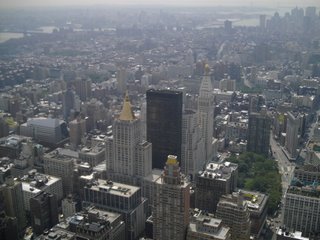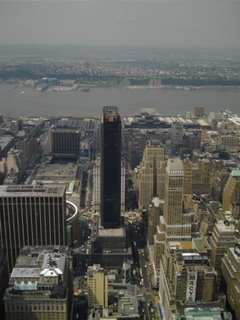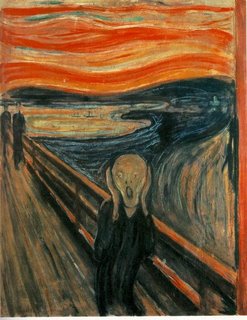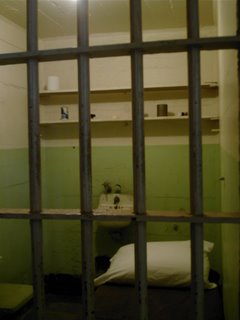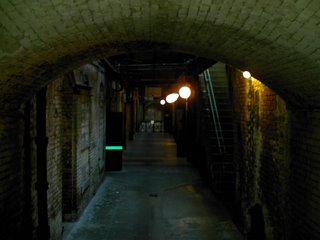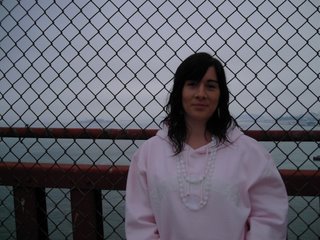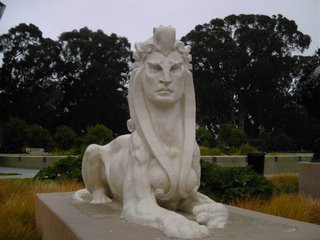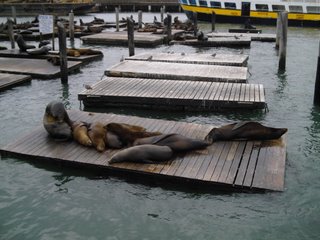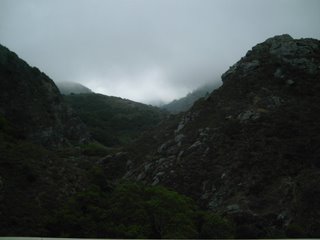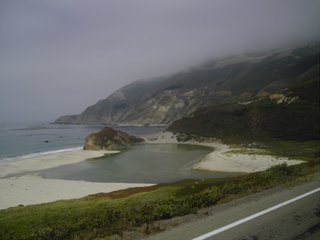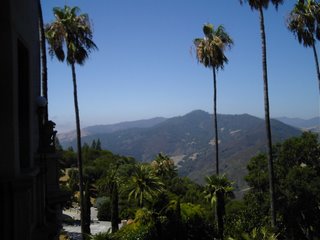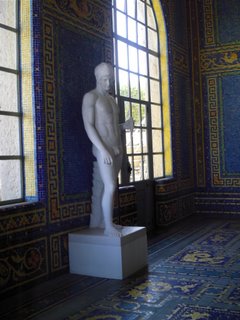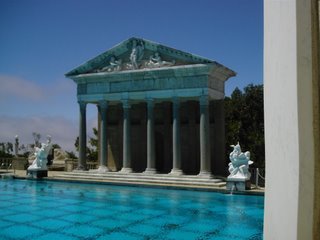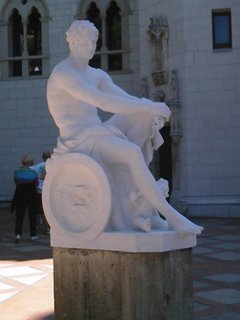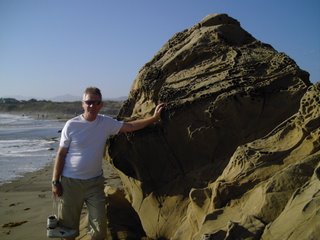Out of Many,One
 On Friday, Dad’s luggage has arrived while we slept. We are up bright and early to get tickets for the downtown tour with Grayline. My friend H, who has recently joined us on the blog and has been to NY a few times now and loves the city, recommended Grayline as one of the best ways to get around the city (other than walking, of course). We buy our tickets and jump on a bus guided by the slightly intimidating Vee, who repeats an identical refrain every time someone new got on the bus. She has an interesting habit of accentuating every other word or so when she speaks.
On Friday, Dad’s luggage has arrived while we slept. We are up bright and early to get tickets for the downtown tour with Grayline. My friend H, who has recently joined us on the blog and has been to NY a few times now and loves the city, recommended Grayline as one of the best ways to get around the city (other than walking, of course). We buy our tickets and jump on a bus guided by the slightly intimidating Vee, who repeats an identical refrain every time someone new got on the bus. She has an interesting habit of accentuating every other word or so when she speaks."Purleese, do not speak during the tour. It will disturb your neighbour from hearing the information that I have to give you."
She means it too, because if you dare to speak to your neighbour, then Vee is on you like a guided missile, shouting at you in front of everyone to stop talking. It always works.People actually look ashamed.
 So, while we are all sitting in silence listening to Vee’s commentary about the buildings we are passing, I drift off for a moment and think about New York so far. New York is a very different Beast to California in every sense. It’s metropolitan, it’s cosmopolitan, it’s hydromatic, why it’s – oh no, that’s Greased Lightning, sorry. New York is drier, cooler almost, and I don’t mean the weather. Where California is relaxed, almost - but never quite - to the point of tranquilised, New York is abrupt, take-it-as-you-find-it, uncompromising. Everyone is busy, everyone is going somewhere, but don’t let that fool you, because everyone is also happy to talk to you, and usually happy to help, especially when they hear an accent they don’t recognise. I especially like that the New Yorkers we have met so far have not been inclined to bullshit us either, even when it means telling us something we don’t like. Besides, as far as I’m concerned, if they’re wrong, it’s a bonus. People seem to make their own rules here, and as a result, no one gives a toss what you do. I like that.
So, while we are all sitting in silence listening to Vee’s commentary about the buildings we are passing, I drift off for a moment and think about New York so far. New York is a very different Beast to California in every sense. It’s metropolitan, it’s cosmopolitan, it’s hydromatic, why it’s – oh no, that’s Greased Lightning, sorry. New York is drier, cooler almost, and I don’t mean the weather. Where California is relaxed, almost - but never quite - to the point of tranquilised, New York is abrupt, take-it-as-you-find-it, uncompromising. Everyone is busy, everyone is going somewhere, but don’t let that fool you, because everyone is also happy to talk to you, and usually happy to help, especially when they hear an accent they don’t recognise. I especially like that the New Yorkers we have met so far have not been inclined to bullshit us either, even when it means telling us something we don’t like. Besides, as far as I’m concerned, if they’re wrong, it’s a bonus. People seem to make their own rules here, and as a result, no one gives a toss what you do. I like that.Today, we are headed to the Statue of Liberty, which I suppose is compulsory, and Ellis Island, which I am looking forward to much more. Well, everyone's seen the Statue of Liberty. It was in one of the Superman movies and everything. As we head past Macy's, Vee tells us that they stopped the clock there at the exact time that the Titanic sunk. She also points out the Museum of Sex on Fifth Avenue (I'm serious! Check it out at http://www.museumofsex.com/ - there's a virtual exhibition about the objectification of the American male nude). Dad won't let us go, although I am dying to see the Dildo Exhibition (ok, I made that up, but they do have a special exhibition on Sex Machines, so I'm close, as t'were). I don't see why we can't go, if he's worried about Amy, she'll learn more in there than she will from school, her peers or her parents, if my experiences were anything to go by. We need one of these in Portsmouth - I'll add it to my campaign list.
The architecture here is aah-sum and so eclectic, for example, chapels and churches nestle alongside skyscrapers all over the city. I love the cast iron facades of the buildings all over the city, which can be replaced with new ones, amazing. We pass the Tiles for America site, showing tiles sent from all over the US and the world to remember those who died in 9/11. We also see the Salvation Army's world HQ, which was responsible for bringing in over 20,000 volunteers to help in the aftermath of the disaster, Vee tells us. We go through Greenwich Village, known for its bohemian history and nature, and Vee tells us that this is where some of the left wing radicals in their field took root in the past, including Bob Dylan and Bill Hicks' forefather, Lenny Bruce. We also see a Picasso statue, Bust of Sylvette, which is visually stunning, especially if you are a fan.
It's been easier on us all here in New York, with real walls and no driving or navigating or booking campsites to worry about. This has taken the strain of the cabin fever off the group, but there is still the dailiness of family life to contend with. Does anyone reading know a family that doesn't bicker and fight over the dumbest stuff ever? I'm not pointing fingers here, because I am just as guilty of it as anyone else, but if it's normal behaviour, why do we always get so angry about it?! And why is it always over the tiniest thing? Let me give you an example, over dinner last night:
Dad: You didn't sleep with your air-con on, did you?
Amy: Aaah, no Dad (tone of pained patience), it's too loud. Duh.
Dad: Well, I found it hard to sleep because the sound from the street is so loud, all the cars and sirens and voices. I like silence when I sleep.
Amy: No way (looks at Dad like he is turning into a cockroach before her eyes). I like noise, silence is scary.
Sarah: Me too, I find silence more disarming.
Dad: (laughing like I'm the funniest non-ginger this side of Brooklyn) I think what you mean is disconcerting, because disarming means -
Sarah: (instantly furious at being corrected, and knowing he's right only makes it worse) Don't tell me what I mean.
Dad: (Looking offended) I'm just saying it's not the right word. You meant disconcerting.
Sarah: (Raising voice) Don't tell me what -
Amy: Would you two please shut up? God. You're so embarrassing.
A resentful silence resumes. It's all the shared history isn't it? Every action referring to a million events that preceded them. Amy, Dad and I are one extreme to another, like the little girl with the little curl (right in the middle of her forehead).
I conclude that NY is like London, but bigger and taller and easier to navigate. Most of the time it's cheaper, too. It even has its own Soho, to make the analogy. Although New York is biggger, it feels like it's more compact than it actually is, because there is so much going on everywhere. The Grayline Tours are good for this reason, because if you're new to the city, they give you time and context to get acclimatised. We leave Vee at Battery Park at Seaport and head to the ferry terminal. We decide not to get off at Liberty Island because the queues to reboard the ferry are so huge. The statue itself is very beautiful, and that girl has a healthy figure, if you ask me, she was not afraid of the odd cream cake and I'm glad of it. But she is smaller than I thought she would be, is that a common reaction, or does the TV just add height?!
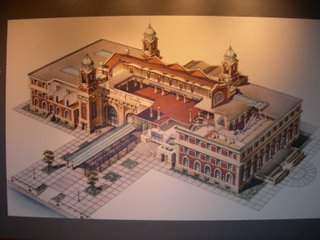 Ellis Island is a real learning curve. The exhibition encourages visitors to reflect not only on the unique history that is presented here, but also on the diversity of the American nation, in terms of what American identity really means, as well as the more obvious issues of race and ethnicity. The information is beautifully presented too, and I take my hat off to anyone who can make statistics as interesting as they are here. the interpretation is fabulous. Ellis Island charts the history of American immigration, through the history of this unique island building, which was the first Federal immigration station in the country. It has been estimated that nearly half of all Americans today can trace their family history to at least one person who passed through here, so it was a must on our list. We search for any Chevertons that may have passed through here and find about 14 of them, including a Tasmanian, George Cheverton, who sailed here from England in 1903. Go to the website and have a look for your family members at: http://www.ellisisland.org/search/passSearch.asp.
Ellis Island is a real learning curve. The exhibition encourages visitors to reflect not only on the unique history that is presented here, but also on the diversity of the American nation, in terms of what American identity really means, as well as the more obvious issues of race and ethnicity. The information is beautifully presented too, and I take my hat off to anyone who can make statistics as interesting as they are here. the interpretation is fabulous. Ellis Island charts the history of American immigration, through the history of this unique island building, which was the first Federal immigration station in the country. It has been estimated that nearly half of all Americans today can trace their family history to at least one person who passed through here, so it was a must on our list. We search for any Chevertons that may have passed through here and find about 14 of them, including a Tasmanian, George Cheverton, who sailed here from England in 1903. Go to the website and have a look for your family members at: http://www.ellisisland.org/search/passSearch.asp.There are some great exhibitions here, and we spend most of the day on the Island. There are some beautiful portraits of the many immigrants who came here scattered throughout and their reasons for leaving were as diverse as those of the immigrants travelling the world today, looking for a better future or just fleeing for survival. It is a hard task to judge who is worthy of admission to a country and Ellis Island also makes you think, quite explicitly, about the impact our cultural understandings of different races, or even contemporary world events such as wars or revolutions can have on our perceptions of entire nations and the inidividuals who originate from them. For example, there is a section on the treatment of the Chinese in the US, which also features Angel Island heavily, where the Chinese were detained and often deported from San Francisco when they had fulfilled their purpose building the Railway.
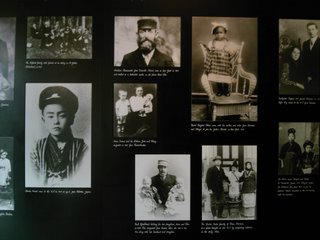
Immigrants underwent medical tests, literacy tests, psychological and intelligence tests as part of the criteria for acceptance, often separated from their families for long periods, sometimes of many months in duration if one family member was sick. Compassionate treatment was not high on the list of priorities and the architecture of the island does not let you forget you are in an institution. If you failed one of the tests, you were given a chalk mark on your person to mark you as requiring more testing or to be detained pending return to the port you sailed from. There are also heart-rending stories of families being split up and some members returned home, or of family members falling sick and dying before they ever got a chance to see their new homeland.
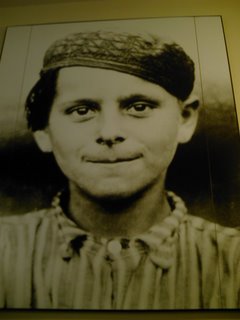 Upstairs, there is an amazing exhibition about the out-buildings of the Island, the accomodations, hospitals and so on, which are not accessible to the public. These photos were taken when these buildings had not been touched and they have the air of urban exploration about them, with original artefacts scattered around and entire rooms left exactly as they were when the immmigration station closed. I would love to get into these buildings, they look amazing and re-kindle my interest in urban exploration, which I would love to get into when I get back home. (If you're new to urban exploration see http://en.wikipedia.org/wiki/Urban_exploration for more info).
Upstairs, there is an amazing exhibition about the out-buildings of the Island, the accomodations, hospitals and so on, which are not accessible to the public. These photos were taken when these buildings had not been touched and they have the air of urban exploration about them, with original artefacts scattered around and entire rooms left exactly as they were when the immmigration station closed. I would love to get into these buildings, they look amazing and re-kindle my interest in urban exploration, which I would love to get into when I get back home. (If you're new to urban exploration see http://en.wikipedia.org/wiki/Urban_exploration for more info).After more hours than I can remember, we catch the ferry back and walk through Battery Park towards the site of the Twin Towers, Grand Zero. At the outskirts of Battery Park, a huge battered metal sculpture called 'The Sphere' by Fritz Koenig stands as a memorial to the events of 9/11 and a constant flame burns before it. This once stood at the WTC as a symbol of world peace and was re-located here on March of the year after the attack. We walk further towards Ground Zero and the site knocks the air from my lungs as I take in just the physical destruction at first, of what happened here, and the huge void that remains as a result. As we get closer to the site and as I look at the photos that are hanging here in tribute to the events of that day, one image - of people staring upwards towards the towers, out of shot, the expression on their faces, and the dawning realisation of the meaning of what they are seeing - steals my breath and I start to cry. It is hard to describe the effect that this site has on you, seeing the panels containing the list of names of the people that died here that day. The wind that now runs freely through this empty space and the absence reflected in the glass of the surrounding skyscrapers convey a horror that is beyond words and my mind runs still and silent with it. I believe that places such as these hold the terrible events that happened within them somehow, and I think the city is right not to attempt to rebuild the towers, but rather to make this site a lasting memorial.
This place is filled for me with the memory of the events that happened here, an atmosphere filled with grief and waste, the sheer, empty, hopeless futility of man's inhumanity to man. And this is only one example, in one place, in one country in the world. Every country has a site or many sites like this one and the reaction to such places, to such events should always be the same: pure horror, pure sorrow, pure determination for such violence, and the many forces and events that inspire and underlie it to cease. The ending has to start somewhere. This starts with us, as individuals, long before it gets to the actions of a nation state. It starts with me not losing my temper when the computer fires up too slowly and bashing it one, it starts with me being more patient, more compassionate, more tolerant, more understanding and above all, more involved in the human race. Maybe the question I would start with is, what is that we are racing for? And where are we racing to?


